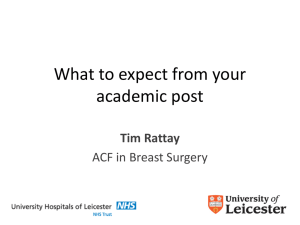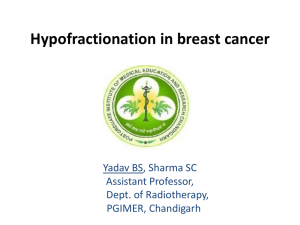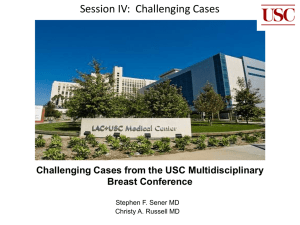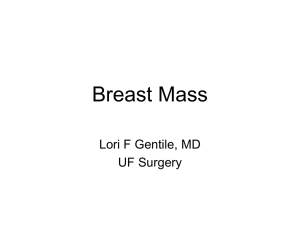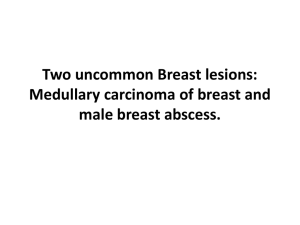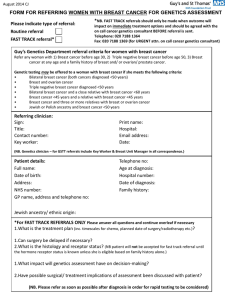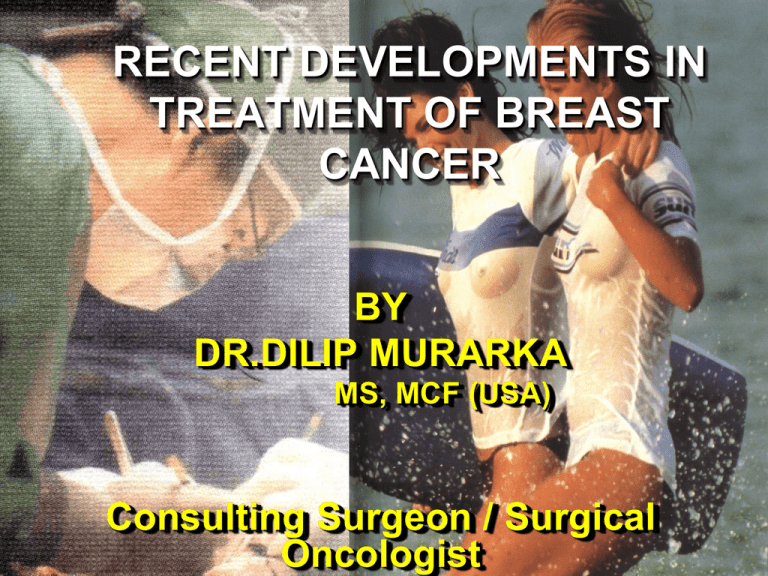
RECENT DEVELOPMENTS IN
TREATMENT OF BREAST
CANCER
BY
DR.DILIP MURARKA
MS, MCF (USA)
Consulting Surgeon / Surgical
Oncologist
Hospitals Attached:
S.L.Raheja (Asian Institute of Oncology,) Mahim
Saifee Hospital, Charni Road
Sushrut Hospital, Chembur
Bharatiya Arogya Nidhi Hospital, Juhu
Breach Candy Hospital
Sujay Hosp, Vile-Parle
Kohinoor Hospital, Kurla
Cumbala Hill Hospital, Kemp’s Corner
Criti Care Hospital, Juhu
Guru Nanak Hospital, Bandra
Surana Hospital –Malad & Chembur
Ramkrishna Mission Hospital, Khar
Parts of the Breast
Breast (Sagittal View)
BREAST CANCER
Statistics
Mortality all over the world
400,000 annually
Mortality in U.S.A.
43,000 annually
Incidence in U.S.A.
1,80,000 in women
1,000 in men
Age adjusted incidence U.S.A. [White]
U.S.A. [Black]
1983 study
87/100,000
104.2/100,000
Bombay cancer registry [1987] Parsee Hindu
47.2%
22.8%
Mumbai
20.5/100,000
Muslim
Christian
25.7%
26.2%-
BREAST CANCER
SCENARIO
The incidence of breast cancer is rising in every country of the
world especially in developing countries such as India.
Incidence
Incidence is rising in India
1 in 28 women (urban areas)
1 in 80 women (rural areas)
It is more prevalent in the higher socio-economic groups.
Roughly 100000 new cases annually
approx 3% increase per year
Tata Hosp - Registered new cases annually - 2000
Early breast cancer 55%
Locally advanced 35%
SIGNS
No Classic Signs
Certain specific signs
-Peau d’orange
-Inflammatory
Ca Breast
-Paget’s disease
RISK FACTORS FOR
BREAST CANCER
Female sex
Age
Parity
Family history
Genetic factor
Intermediate risk factors
Early menarche, Late menopause
Exposure to radiation
Oral Contraceptives
Smoking / Alcoholism / High fat diet
Atypia /Hyperplasia
Women on HRT
Groups
Operable Breast Cancer T < 5 cm,
N0 or N1, Mo
Large Operable Breast Cancer
T > 5 cm, N0 or N1, M0
Locally Advanced Breast Cancer
Metastatic Breast Cancer
Early Stages of
Breast Cancer - Stage 0
Early Stages
of Breast Cancer - Stage 1
Early Stages
of Breast Cancer - Stage 2
Advanced Stages
of Breast Cancer - Stage 3
Advanced Stages
of Breast Cancer - Stage 4
Locally Advanced
Breast Cancer
Skin involvement : oedema, ulceration,
infiltration, satellite nodules
Axillary Nodes : Matted / Fixed
SC/IMC (Ipsilateral)
Chest wall fixity
Arm Oedema
Operable Breast Cancer
T/N Staging (Clinical)
Histology (FNAC / Incision Bx)
Bilateral Film Mammogram (for BCT)
Eg/PgR (for NACT)
Routine Pre Anesthetic Work up
Metastatic Work up Not Recommended (< 2 %)
STRONG CLINICAL SUSPICION – OVERRULE NEGATIVE
FNAC / MAMMOGRAPHY FOR EXCISION Bx
Operable Breast Cancer
Surgical Options :
Breast Conservative Therapy (BCT)
Wide Excision with Complete Axillary Clearance
Modified Radical Mastectomy (MRM)
Lumpectomy
Lumpectomy
Is the removal of the breast
cancer and a portion of
normal tissue around the
breast cancer lump
(the areas removed during
the surgery are shaded in
green).
Lumpectomy
Simple
Mastectomy
Total (or simple) mastectomy
During a total (or simple)
mastectomy, the surgeon
removes the entire breast
(including the nipple, the
areola, and most of the
overlying skin) and may
also remove some of the
lymph nodes under the
arm
Simple Mastectomy
Modified Radical Mastectomy
Modified Radical Mastectomy
Radical mastectomy
During a radical
mastectomy, the surgeon
removes the entire breast
(including the nipple, the
areola, and the overlying
skin), the lymph nodes
under the arm
Quadrantectomy
(Partial Mastectomy)
Quadrantectomy
(Partial Mastectomy)
Partial
(segmental) mastectomy
Involves the removal of the
breast cancer and
a larger portion of the
normal breast tissue
around the breast cancer
(the areas removed during
the surgery are shaded in
green).
Showing Upper Flap
Showing a specimen of Lumpectomy
After MRM
Showing Upper & Lower Flap
Final Scar
Operated Specimen
Operable Breast Cancer
Contraindications to BCT :
Multicentric disease (> 1 quadrant)
Extensive microcalcification on Mammogram
Doubtful Compliance with RT
Pregnancy (1st / 2nd Trimester and Precious
child
Cosmesis unsatisfactory
Models Histopathology Report
Tumour Size (3 D), Type, Grade (MRB Score)
Presence of Extensive Intraductal Carcinoma (EIC)
Lymphovascular Embolisation
Cut Margin Status
No of Nodes +ve / Total No. of Axillary Nodes
Receptor Status : ER and PgR
Adjuvant Therapy
A. Systemic : Hormone therapy and/or Polychemotherapy
All women with N+ and/or ≥ 1 cm tumour
ER or PgR +ve
ER & PgR –ve
Premenopausal
Chemotherapy +
Hormonal therapy
Chemotherapy
only
Post menopausal
Hormonal therapy
+/- Chemotherapy
Hormonal therapy
+ Chemotherapy
B. Low Regional : Radiotherapy
All women with BCT
All women with MRM with T > 5 cm, > 3 +ve nodes
Locally Advanced Breast Cancer
Core / Incisional Bx for diagnosis / receptor study
Mammo Sonography – Document tumour size
Metastatic workup – X-Ray Chest, USG Abdomen,
LFT, Bone Scan
Treatment Sequence – NACT – Surgery – Adj. CT
– RT (Plus Tain If ERHC)
Locally Advanced Breast Cancer
Surgical Options :
Clinical / mammography CR Index quadrantectomy
with axillary clearance (BCT)
PR (residual disease) a) BCT when feasible
b) Simple mastectomy with
axillary clearance (SMAC)
SD or PD SMAC with or without reconstruction
for skin cover
PD and Inoperable Preop RT Reasses for Surgery
Follow Up After Primary Treatment
I.
PE every 3 months x 2 years, biannually x 3 years,
then yearly
II.
Mammography – Annually
III. No other investigation in Asymptomatic patients
Not cost effective, Does not prolong survival,
Psychological harm
Follow Up After Primary Treatment
Clinical recurrence or Symptoms s/o metastases :
X-ray Chest
USG Abdomen
LFT
Bone Scan
Skeletal Survey (Suspicious / weight bearing areas)
CT / MRI as indicated
Breast Cancer Screening
1) Periodic mammographic screening : 30 %
Reduction in mortality in women > 50 years
No convincing evidence of benefit in women < 50 years
2) Not sustainable in developing countries
3) Physical Examination (PE) of breast by trained
personnel
Sensitivity 75 %, Specificity > 90 % ;
?? Alternative to Mammography
4) Breast Self Examination (BSE) may identify interval
cancers early ; No survival benefit
Family History of Breast Cancer
Confers 2-3 fold increased risk of developing breast cancer
5-10 % of such women have an over 50 fold risk
Related to mutations in BRCA 1 and BRCA 2 genes
First degree blood relatives may be tested if these mutations
confirmed in the index cases
Negative Genetic testing does not eliminate risk
Positive test cannot be remedied or prevented from being
transmitted vertically
Genetic testing provides information in a research setting
but use in routine practice needs evaluation, social debate
and counselling
EBM Guidelines
Breast conservation therapy is the gold standard
for Early Breast Cancer provided negative
resection margins are achieved and an acceptable
cosmetic result can be obtained
Modified Radical Mastectomy remains the standard
of treatment when disease is multicentric or
compliance to postoperative radiotherapy is
doubtful
EBM Guidelines
Adjuvant Chemotherapy reduces death due to
breast cancer by 25 % (RR) in premenopausal
women
Effect is halved in postmenopausal women
Adjuvant Tamoxifen reduces death in hormone
sensitive breast cancer by 26 % (RR) irrespective
of menopausal status
EBM Guidelines
Intensive investigations are not recommended
to detect metastases during routine follow up
of women after completion of primary treatment
Investigate only when symptomatic
EBM Guidelines
Screening Mammography alone is effective in
saving lives in Post Menopausal Women
Physical examination “as effective” – one
randomized trial
Premenopausal Women – Screening by
Mammography and/or PE is debatable
Recommended Screening Tests
for Women By Age Groups (NCI)
Age
Recommendation Benefit
Under
age 40
Breast exam by doctor No data
Age 40
to 49
Breast exam by doctor May reduce her chances of
dying from breast cancer
Mammogram every 1
by about 17 percent
to 2 years
Age 50
to 74
Breast exam by doctor May reduce her chances of
dying from breast cancer
Mammogram every 1
by about 30 percent
to 2 years
Age 75
and
above
Breast exam by doctor No data
Mammogram every 1
to 2 years
Mammography
Needle (core) biopsy
Ultrasound
Management of Metastatic
Breast Cancer
Main goal is palliation
Hormone therapy (Based on ER-PR status)
Tomaxifen 20 mg / Letrozole (2.5 mg)
Oophrectomy – premenopausal ER-PR +
second line treatment
Chemotherapy – ER-PR –ve CAF, CMF, CEF
paclitaxel
Radiotherapy – Bone metastases – pain
relief – neurological & skeletons.
Complication of bone mets.
Brain Metastasis :- Relieving / Preventing
neurological manifestation single & multiple
Frequently Asked Questions
(FAQ’s)
Is everything in breast malignant ?
Is there any non surgical Rx to breast
malignancy ?
What is hormone or chemotherapy ?
When do they begin ?
Are there any side effects with chemotherapy ?
What are the advices given to the patient who is
an chemotherapy by the doctor ?
Frequently Asked Questions
(FAQ’s)
Will there be any disturbances in the menstrual
cycle ?
Is hair loss permanent or not ?
Will my breast be removed due to breast
malignancy ?
Are there any cosmetic procedure available after
breast Sx ?
What is radiation therapy and what are its side
side effect ?
Role of
Immuno - modulators
in the cancer treatment


